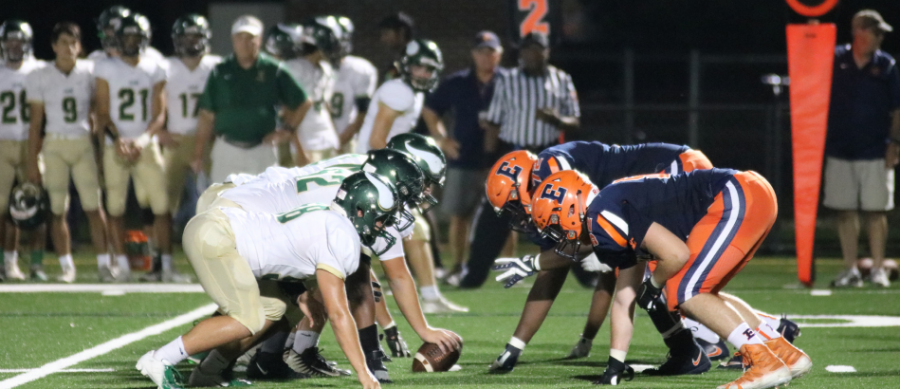Addicted- the complex relationship between athletes and social media
Wildkits face off against the Fremd Vikings on Sept. 20th.
September 27, 2019
Wake up, check your phone. Get to school, check your phone. Finish practice, check your phone. Go to bed, check your phone. Repeat.
Whether we realize it or not, in today’s day and age, we are sucked into our screens. The routine of constantly checking our devices and social media for updates has become a subconscious motion for a majority of us.
Social media has encompassed our lives and has become a space to record our every move. Despite being around for less than 15 years, platforms such as Instagram, Snapchat, and Twitter have become ways for people to stay updated not only with friends and family, but with national news.
Athletes are no different. Social media is now used to do everything from staying up to date with your favorite team to contacting coaches for recruitment. Twitter has enabled aspiring collegiate athletes to post their highlights for schools to see as well as to make contact with schools interested in them.
While social media may seem to be a complete slam dunk for athletes, it has the potential to become the total opposite. Cyberbullying and addiction to social media can cause athletes to fall into a black hole. The same platforms that can cause glory can also be the cause of internal suffering due to received hate.
Social media has become a double-edged sword for many. While it has opened so many gateways of opportunity for athletes, it has also become a toxic platform for some, which begs the question: are athletes better off with social media?
The feeling for an athlete who has worked their whole life to perfect their craft to sign a letter of commitment to continue their career at the collegiate level is tough to match and for many, social media is at the forefront of their actions.
Before even reaching out to coaches, athletes can learn a tremendous amount online. Without even going to the campus, students can find out basic information about the college of their choice.
“I would say Twitter helped me see what kind of program the team was running and the scores the teams got,” senior football player Aidan McMahon said. ”Coaches will hit you up on Twitter from schools you don’t really know from before.”
Social media, having originated within the past 15 years, is still a new idea for coaches, but has become a tool for schools and players nation-wide.
“I can remember seven or eight years ago when a prospect would come on campus, it was really the first time they were meeting coaches, seeing facilities and learning about your program,” Clemson University football Offensive Coordinator Jeff Scott said in a 2018 interview with USA Today. “Now, prospects know a ton about Clemson before they even step foot on campus. They have a greater feel for what we are all about because of what they see on social media.”
Social media can play different roles depending on the sport of interest though. For typically larger scale recruitment sports such as football and basketball, uploading highlight reels can mean the difference between whether they receive an offer or not. For many sports, Twitter is the perfect way to spark a conversation with programs of interest.
“I think for football and basketball, social media definitely helps a lot just because they are posting where they got offers from and it helps show other coaches where you do have offers from,” senior and Princeton softball commit Molly Chambers explained. “For softball it’s a little bit different because players often don’t post where they have offers from. It’s more of a way to reach out to coaches and say I’m interested in this school [and ask] is there anyway I could come out and visit?”
A large scale operation like collegiate recruitment is not the only use for media. Looking at a local level, publicizing one’s games can be done with the press of a button.
Because of the huge range of people and fans that have a presence on social media, different platforms offer different benefits.
Posts on Instagram or Snapchat’s 24 hour long “stories” are more likely to capture the immediate eye of many, while posts on Facebook or Twitter are able to provide a greater amount of information for interested fans. Whether it be from a player or the ETHS Athletics Twitter, which tweets and retweets information on scores, upcoming games and general athlete news around ETHS, online sharing has become a great space to spread news for one’s sport.
“It’s a fun way to celebrate our kids. I take advantage of the fact that we have some audience out there, I can send out ‘commercials’ about character, passion, and our core values, the more important part of sports,” ETHS Athletic Director Chris Livatino said.
Social media can be a game-changer if used in the right ways. It isn’t only used for mindlessly scrolling through your feed, but as a starting point for serious athletes who want their moment of clarity and feeling of satisfying self-accomplishment.
“Social media has helped with connecting to coaches and schools that I didn’t even think of,” McMahon explained. “It’s been a great help overall, and it’s definitely the new way of communicating with college coaches.”
While social media can be a place of positivity and activism, it can also become toxic in the blink of an eye.
“At their worst, [social media platforms] are divisive, negative, and display the darker side of sports,” Livatino said.
A 2019 study on the correlation of social media usage and mental health issues funded by the U.S. National Institutes of Health found from the nearly 1,800 individuals in the study, those who used social media the most were 2.7 times as likely to develop depression than their counterparts (Behavioral Health of the Palm Beaches).
What really drives this information for athletes in particular are the negative comments that come one’s way after a single mistake or unpopular decision.
Looking at a professional level, in the 2019 NFL playoffs Bears kicker Cody Parkey missed a game winning field goal. Rather than fans consoling him for his mistake, fans chose to take to his social media accounts as a way to bash Parkey, from using him as a meme format to commenting threats such as “…the hood is going to be coming for life.” creating a dangerous environment for Parkey to live his life in peace.
“In high school you don’t see it as much, but at the collegiate and professional level, what fans think they can say to athletes over social media are completely out of bounds,” Livatino explained.
Coverage from sport to sport can often be difficult to balance for a school as large as ETHS. With over 30 different sports to cover, often it can feel that a certain sport is forgotten, which can be discouraging for athletes.
“When Mr. Livatino forgets to tweet about a game he gets a lot of backlash about that,” senior and co-head of The Pride Sylvi Imrem said. “Talking to him I’ve come to realize that the social media part of his job is not the biggest part of his job, so I would say another negative is people get too fixated on social media.”
Even for those who typically stay away from the buzz of ETHS Twitter, the significance of these platforms remain. The world of collegiate recruitment, while offering a number of great opportunities for athletes to play on the next level, is one that remains ultra-competitive. For athletes talking to schools, it can become discouraging to see another’s commitment to a school they were interested in.
“It can be a little bit discouraging if you see, from a sports side, someone who has committed somewhere and you were talking to that coach and it’s like someone in your same position and same class where it can be like ‘oh shoot i didn’t even know that was happening’ and that they were talking to someone else,” Chambers explained.
Along with the self-doubt that comes from the college recruitment process, social media can also completely end the chances of a player or even a team’s chances at success.
In the 2013 Evanston baseball season, the team was caught in the middle of an online sexting scandal, which caused the whole team to be suspended and miss the playoffs. Because of the recklessness that resulted from the team’s inappropriate behavior online, a season was lost, which for many was their last time playing baseball at that level. Because of the ease in which one can share content online, the team ended the season not in glory, but in shame.
While there may never be a forgone conclusion on if the ethics of social media usage are out of line, still the debate roars on. The relationship social media has developed with mental health is not one to brag about and in many eyes, including those of Livatino, calls for the extermination of the concept all together.
“If it were up to me, I would love for social media to disappear all together.”











